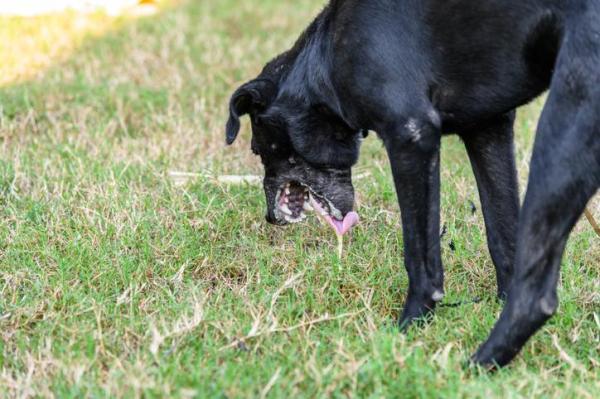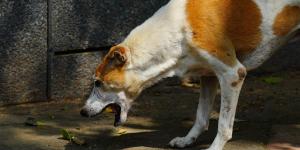My Dog Has Acid Reflux - Symptoms and Treatment



See files for Dogs
Gastroesophageal reflux, more commonly known as acid reflux, occurs when the contents of the stomach and the duodenum rise above the esophagus. This is because they have passed the esophageal sphincter, the valves which normally prevent food from return back from lower in the digestive tract. The ‘acid’ is in reference to gastric acids present in the stomach, but they are not the only irritant which can rise. It is a process which can be very annoying for our dogs, but it can also lead to esophageal injury and even put them at risk of aspiration pneumonia.
In this AnimalWised article, we look at why my dog has acid reflux. We look at the causes, symptoms and treatment of this problem, as well as what we can do to prevent it happening again in the future.
What is acid reflux in dogs?
Acid reflux occurs when the contents of the stomach and duodenum (small intestine) rise up the esophagus. It doesn't need to move all the way out past the top of the esophagus. Since the liquid which is rising is very acidic, thanks to gastric acids in the stomach, it can cause a burning sensation in almost any part of the esophagus. This is the main cause of what we know as heartburn and distinguishes it from a dog vomiting.
The liquids which can rise up as acid reflux include gastric acid, pepsin, trypsin, bicarbonate and bile salts. They can cause irritation to the lining of the esophagus, leading to esophagitis, i.e. inflammation of the esophagus. Esophagitis varies in severity, but it can be very painful for the dog. Mild esophagitis usually occurs when only gastric acid rises and severe esophagitis occurs when all previously stated components rise.
The cardia is the sphincter valve which causes the contents of the esophagus to enter into the stomach. It should prevent the stomach contents from ascending back up the esophagus in the end. When it doesn't, the dog experiences acid reflux. We may not notice it until the acidic contents reach the mouth and our dog throws up yellow bile.
Acid reflux in newborn dogs
Newborn puppies are at a greater risk of acid reflux due to their lack of development. The cardia sphincter is still immature, making it easier for the contents to rise.
Causes of acid reflux in dogs
The main causes that can trigger gastroesophageal reflux in dogs include:
- Chronic vomiting: if a dog is vomiting frequently, the food contents also carry acidic substances since they have begun the digestion process. This can erode the lining of the esophagus and weaken the cardia sphincter. It might occur if your dog keeps vomiting after they eat.
- Hiatal hernia: this occurs when a part of the stomach enters the thoracic cavity through the diaphragm. This condition makes it easier for stomach contents to rise up into the esophagus due to sphincter dysfunction.
- Anesthesia-induced reduction in caudal esophageal sphincter pressure: it occurs especially when the dog is positioned in the supine position (face up), when fasting prior to surgery has not been carried out and as a side-effect of anesthetic drugs.
- Esophagitis: inflammation of the lining of the esophagus is generally accompanied by reflux, because the inflammation makes it difficult for the sphincter to function properly, allowing the content to rise. One induces the other.
- Gastritis: this is another type of inflammation. in this case caused by irritation of the stomach wall. This alteration affects the sphincter, which also allows its content to rise towards the esophagus.
- Obesity: this condition is considered a risk factor for the rise of reflux, mainly due to the pressure of fat on the organs or the fat itself altering the functionality of the sphincter. The same might happen when the dog is fed a high-fat diet.

Symptoms of acid reflux in dogs
Gastroesophageal reflux in dogs, as we have mentioned, can lead to esophagitis. This, in turn, can lead to observing the following clinical signs:
- Vomiting or regurgitation
- Excessive salivation
- Frequent licking
- Pain when swallowing (odynophagia)
- Extension of the head and neck while swallowing
- Reluctance to eat
- Weight loss
- Depression
- Apathy
- Fever if there is severe esophagitis
In some cases, this content in swallowing can enter the lungs and lead to aspiration pneumonia. In these cases, the dog will also present coughing and wheezing (lung sounds). These noises can make it sound like your dog is suffocating, so we need to be very careful and take them to a veterinarian for diagnosis.
Some people think that vomiting white foam in dogs is a symptom of acid reflux, but this is not likely. If the dog has acid reflux which goes into their mouth, it will usually be a yellow bile color, not clear.
Diagnosis of reflux in dogs
The diagnosis of gastroesophageal reflux is usually due to suspicion that this is the problem. This derives from evidence of the symptoms mentioned above. For confirmation, a differential diagnosis of acid reflux in dogs is required, particularly when the following are present:
- Hiatal hernia
- Esophageal stricture
- Esophagitis
X-rays do not help in the diagnosis because they do not usually reflect any alteration in the esophagus. Endoscopy is the best diagnostic method to assess the state of the esophagus and the severity of esophagitis.
The procedure that achieves the definitive diagnosis of sphincter relaxation, but which the vast majority of dogs will not tolerate, is continuous measurement of caudal esophageal sphincter pressure and intraluminal pH over a full day.
How to treat acid reflux in dogs
As we have commented above, diets rich in fat can assist in the relaxation of the caudal esophageal sphincter and delay gastric acid reflux. For this reason, daily fat intake should be reduced in dogs with with acid reflux.
Medical intervention may also be required to treat acid reflux in dogs, which may include:
- Sucralfate to protect damaged esophageal mucosa and promote healing.
- Gastric secretion inhibitors (cimetidine, ranitidine, famotidine, etc.) to reduce the amount of acid going back up the esophagus.
- Proton pump inhibitor (usually omeprazole for dogs) to more effectively reduce gastric secretion and reflux.
- Prokinetics (metoclopramide).
If the dog has developed severe esophagitis and does not want to eat, a gastrostomy tube may be placed to feed them. This bypasses the damaged esophagus and keeps the animal nourished and hydrated. These are important for the dog to heal properly and helps avoid secondary problems.
Are there home remedies for cid reflux in dogs?
It is worth mentioning that there are no home remedies for canine acid reflux, beyond a proper diet. When this problem appears, the dog should be taken to the veterinarian to start treatment and prevent further damage to the esophagus. The only way to relieve acid reflux in dogs is by following the advice of a professional after having them diagnose the underlying cause.
Prognosis of reflux in dogs
If medical treatment is followed and its causes are resolved, the prognosis for gastroesophageal reflux in dogs is usually good.

How to avoid reflux in dogs?
Reflux in dogs can be prevented as long as the animal is given an appropriate diet and we promote healthy lifestyle habits. Since obesity is a contributing risk factor for acid reflux, it is important to maintain the ideal weight for the dog. We do this by avoiding the causes of canine obesity. Of course, we will also need to maintain regular veterinary checkups, something which should be carried out with any dog, regardless if they show signs of acid reflux.
Another way to avoid a dog developing acid reflux is to promote healthy habits in how a dog eats, not just what they eat. Our video below on how many times we should feed a dog explains further:

This article is purely informative. AnimalWised does not have the authority to prescribe any veterinary treatment or create a diagnosis. We invite you to take your pet to the veterinarian if they are suffering from any condition or pain.
If you want to read similar articles to My Dog Has Acid Reflux - Symptoms and Treatment, we recommend you visit our Intestinal problems category.
- Hall, E. J., Simpson, J. W., & Williams, D. A. (2009). Manual of Gastroenterology in Small Animals, 2nd Edition. BSAVA, Ediciones S.
- Thomas, L. E. Acid Reflux in Dogs: Symptoms and Treatments (2019). Available at: https://misanimales.com/reflujo-acido-perros-sintomas-tratamientos/
- Balsameda, Z. (2020). Gastroesophageal reflux in dogs. Available at: https://soyunperro.com/reflujo-gastroesofagico-en-perros/







